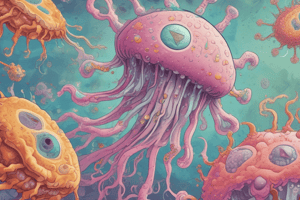Podcast
Questions and Answers
What is the primary mode of transmission of Entamoeba spp.?
What is the primary mode of transmission of Entamoeba spp.?
- Fecal-oral (correct)
- Airborne
- Direct contact
- Vector-borne
What is the characteristic feature of the cyst form of Entamoeba spp.?
What is the characteristic feature of the cyst form of Entamoeba spp.?
- 1 nucleus
- Has ingested RBCs
- Pseudopod formation
- 4 nuclei with splinter-like chromatoid bodies (correct)
What is the diagnostic stage of Entamoeba spp.?
What is the diagnostic stage of Entamoeba spp.?
- Trophozoite only
- Only in asymptomatic carriers
- Cyst and Trophozoite (correct)
- Cyst only
What is a common symptom of amebic colitis caused by Entamoeba spp.?
What is a common symptom of amebic colitis caused by Entamoeba spp.?
What is a possible outcome of Entamoeba spp. infection?
What is a possible outcome of Entamoeba spp. infection?
What type of parasite cannot survive outside of a host?
What type of parasite cannot survive outside of a host?
What is the term for a host that harbors the asexual or larval stage of a parasite?
What is the term for a host that harbors the asexual or larval stage of a parasite?
What is the term for a host that is infected with a parasite but shows no symptoms?
What is the term for a host that is infected with a parasite but shows no symptoms?
What type of infection occurs when an infected individual becomes their own direct source of infection?
What type of infection occurs when an infected individual becomes their own direct source of infection?
Which of the following is an example of a parasite that can cause autoinfection?
Which of the following is an example of a parasite that can cause autoinfection?
What is the term for a parasite that is established outside the body of a host?
What is the term for a parasite that is established outside the body of a host?
Flashcards are hidden until you start studying
Study Notes
Entamoeba spp.
- Most invasive protozoan of Entamoeba species
- Second most important parasite
Life Cycle and Transmission
- Infective stage: Cyst
- Diagnostic stage: Trophozoites, Cyst
- Fecal-Oral Mode of Transmission
Morphology
Cyst Form
- 4 nuclei
- Splinter-like chromatoid bodies
Trophozoite
- 1 nucleus
- Has ingested RBCs (Red Blood Cells)
- (+) Pseudopod formation
Clinical Presentation
- Asymptomatic carrier
- Amebic colitis
- Dysentery
Types of Parasites
- Obligatory Parasite: cannot survive outside of a host
- Facultative Parasite: capable of existing independently of a host, but becomes parasitic when needed
- Spurious Parasite: a free-living organism that passes through the digestive tract without infecting the host
Types of Hosts
- Definitive or Final Host: where the sexual phase of parasite development occurs
- Intermediate Host: harbors the asexual or larval stage of the parasite
- Reservoir Host: harbors the parasite, allowing the life cycle to continue and become additional sources of human infection
- Accidental Host: hosts other than the normal one that are harboring a parasite
- Carrier: parasite-harboring host that is not exhibiting any clinical symptoms, but can infect others
Special Types of Infections
Autoinfection
- Infected individual becomes their own direct source of infection
Superinfection
- Infected individual is further infected with the same species, leading to massive infection
- Examples: Capillaria philippinensis, Cryptosporidium, Hymenolepis nana, Enterobius vermecularis, Strongyloides stercoralis, Ascaris lumbricoides
Studying That Suits You
Use AI to generate personalized quizzes and flashcards to suit your learning preferences.



